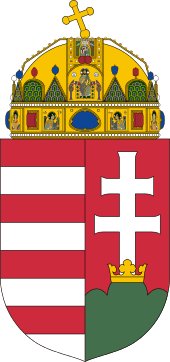Anti-Hungarian sentiment
Anti-Hungarian sentiment (also known as Hungarophobia,[1][2] Anti-Hungarianism, Magyarophobia[3] or Antimagyarism[4]) is dislike, distrust, racism, or xenophobia directed against the Hungarians. It can involve hatred, grievance, distrust, intimidation, fear, and hostility towards the Hungarian people, language and culture.
History
During the era of the Austro-Hungarian monarchs, the court in Vienna was influenced by Hungarophobia, but the Hungarian landowner nobles also showed signs of Germanophobia.[5] In the 18th century, after the end of Rákóczi's War of Independence, many immigrants came to the underpopulated southern parts of the Kingdom of Hungary: for instance, 800 new German villages were established.[6] The authorities preferred non-Hungarian settlers. The Habsburgs regarded Hungarians as "politically unreliable" and so were not allowed to settle in the southern territories until the 1740s.[7] The organized resettlement was planned by the Habsburgs. The resettlement policy was characterized as anti-Hungarian,[8][9] as the Habsburgs feared an uprising of Protestant Hungarians.[10]
Thousands of Hungarians were massacred in Transylvania in 1848-49 (now part of Romania) in nine separate incidents during the Hungarian Revolution of 1848.
Modern
Czechoslovakia
Minorities in Czechoslovakia in 1918 to 1939 enjoyed personal freedoms and were properly recognized by the state. There were three Hungarian and/or Hungarian-centric political parties:
- Hungarian-German Social Democratic Party
- Hungarian National Party
- Provincial Christian-Socialist Party
After World War II, Czechoslovakia became a communist state; during the transition to a communist one-party state, decrees permitting the forced[11] expulsion of German and Hungarian minorities from ethnic enclaves in Czechoslovakia came into effect, and Hungarians were forcibly relocated to Sudetenland, on the borders of Czechoslovakia. The Czechoslovak government deported more than 44,129 Hungarians from Slovakia to the Sudetenland for forced labor[12][13] between 1945 and 1948,[13] and the Beneš decrees remain legally in effect in the Czech Republic.[14]
Slovakia
In Slovakia, Hungarian and pro-Hungarian political parties are a stable part of the political system. Anti-Hungarian sentiment had been criticized particularly during the third government of Vladimír Mečiar. In the past, so-called "Hungarian card" had been used mainly by the Slovak National Party (SNS)[18] against the granting of a special status to the Hungarian minority; it argued for the complete assimilation of the Hungarian minority into Slovak society. It considers that Hungarians in Slovakia are actually overprivileged.[18][19] After personnel changes in the presidium, SNS abandoned similar rhetoric and formed a common government with pro-Hungarian Most-Híd in 2016.
Anti-Hungarian rhetoric of some far-right organizations in Slovakia is based on historical stereotypes and conflicts in the common history as interpreted from nationalistic positions and recent events. In such interpretations, the arrival of old Hungarian tribes is described as the occupation by barbarian tribes and contributed to the destruction of Great Moravia. Other negative sentiments are related to the period of Magyarization, the policy of interwar Hungary, the collaboration of Hungarian-minority parties with the Hungarian government against Czechoslovakia, the First Vienna Award and the Slovak–Hungarian War.[20] Hungary is accused of still trying to undermine the territorial integrity of Slovakia, and local minority politicians are accused of irredentism.[20] However, anti-Hungarian sentiment is not typical even for all far-right organisations, and the leader of the Slovak Brotherhood emphasized the need for collaboration with Hungarian far-right organisations against materialism and multiculturalism.[20]
Women, Slovak or not, used to be required to affix the Slovak feminine marker -ová (used for declension of feminine names) at the end of their surname.[21]
One incident of ethnically-motivated violence against Hungarians in Slovakia is the Hedvig Malina case. The 23-year-old Hungarian student from Horné Mýto was allegedly beaten and robbed in Nitra after speaking Hungarian in public.[22][23][24] A football match in Dunajská Streda also caused tensions between Slovakia and Hungary when Hungarian fans were badly beaten by the Slovak police.[25]
The majority and the Hungarian minority describe their coexistence mostly as good. For example, in a public survey in 2015, 85.2% of respondents characterized their coexistence as good (63.6% rather good, 21.6% very good) and only 7.6% as bad (6.3% rather bad, 1.3% very bad).[26]
Romania
In Romania, the Ceaușescu régime was obsessed with the ancient history of Transylvania[27] The National Communism in Romania made[28] the historical personalities of Hungary (such as John Hunyadi or György Dózsa)[28][29] go through Romanianization and become more central figures in Romanian history.[27]
Derogatory terms
In English
In Romanian
- Bozgor (m), Bozgoroaică (f), Bozgori (pl.) – pseudo-Magyar term of possible Romanian/Slav origin. An ethnic slur describing Hungarians. A view is that it means "homeless","stateless"".[32] N. Sándor Szilágyi speculated that the word is a combination of the Hungarian slur ba(s)zd meg ("fuck you") and the Romanian word for Hungarian, namely ungur[33]
See also
References
- Viktor Karády, The Jews of Europe in the Modern Era: A Socio-Historical Outline, Central European University Press, 2004, p. 223
- András Bán, Hungarian-British Diplomacy, 1938-1941: The Attempt to Maintain Relations, Routledge, 2004, p. 128
- Boyer, John W. (2009). Culture and Political Crisis in Vienna: Christian Socialism in Power, 1897-1918. University of Chicago Press, 1995. p. 116. ISBN 9780226069609.
- Verdery, Katherine. National Ideology Under Socialism: Identity and Cultural Politics in Ceauşescu's Romania. University of California Press, 1995. p. 317. ISBN 9780932088352.
- Michael Hochedlinger, Austria's Wars of Emergence: War, State and Society in the Habsburg Monarchy, 1683-1797, Pearson Education, 2003, p. 25
- Thomas Spira, German-Hungarian relations and the Swabian problem: from Károlyi to Gömbös, 1919-1936, East European quarterly, 1977, p. 2
- Károly Kocsis, Eszter Kocsisné Hodosi, Ethnic Geography of the Hungarian Minority on the Carpathian Basin, Simon Publications LLC, 1998, pp 140 -141
- Hídfő könyvtár, Volume 8, Issue 1, p. 48
- Istvàn Sisa, Magyarságtükör: nemzet határok nélkül, Püski, 2001, p. 99 Cited: "Magyarellenes betelepítési politika. A felszabadulást követően a Habsburgok olyan betelepítési politikát alkalmaztak, mely még tovább gyengítette a magyarok helyzetét." Translation: "(Section name) Anti-Hungarian resettlement policy. After the liberation, the policy employed by the Habsburgs weakened the situation of Hungarians more."
- Tibor Iván Berend, Éva Ring, Helyünk Európában: nézetek és koncepciók a 20. századi Magyarországon, Volume 1, Magvető, 1986, p. 144 Cited: "A Habsburg-család azonban a kálvinista magyarok lázadásától való félelmében az évszázados török háborúk által elpusztított területen magyarellenes telepítési politikát kezdeményezett" Translation: "The Habsburg family initiated an anti-Hungarian resettlement policy in the destroyed territories (caused by hundreds of years of Turkish wars) because of their fear of an uprising of Calvinist Hungarians"
- Thum, Gregor (2006–2007). "Ethnic Cleansing in Eastern Europe after 1945". Contemporary European History. 19 (1): 75–81. doi:10.1017/S0960777309990257.
- Eleonore C. M. Breuning, Dr. Jill Lewis, Gareth Pritchard, Power and the people: a social history of Central European politics, 1945-56, Manchester University Press, 2005, p. 140
- Anna Fenyvesi, Hungarian language contact outside Hungary: studies on Hungarian as a minority language, John Benjamins Publishing Company, 2005, p. 50
- "Radio Prague - The "Benes decrees" - a historian's point of view". Retrieved 25 September 2015.
- "Separatist Movements Seek Inspiration in Kosovo". Der Spiegel. 2008-02-22. Retrieved 2008-08-06.
- Jan Cienski. "Slovakia and Hungary just won't get along". GlobalPost. Retrieved 25 September 2015.
- SPIEGEL ONLINE, Hamburg, Germany (25 August 2009). "The World from Berlin: Slovakia and Hungary 'Dangerously Close to Playing with Fire'". SPIEGEL ONLINE. Retrieved 25 September 2015.CS1 maint: multiple names: authors list (link)
- Cohen, Shari J. (2009). Politics Without a Past: The Absence of History in Postcommunist Nationalism. Duke University Press, Nov 22, 1999. p. 140. ISBN 0822323990.
- Hungarian Human Rights Foundation Archived 2011-01-05 at the Wayback Machine New Slovak Government Embraces Ultra-Nationalists, Excludes Hungarian Coalition Party
- Danilov, Sergej; Nociar, Tomáš, eds. (2012). Milovaní a nenávidení: Podobnosti a rozdiely medzi slovenskou a maďarskou krajnou pravicou [Loved and hated: Similarities and differences between Slovak and Hungarian far-right]. Bratislava: Inštitút pre medzikultúrny dialóg. pp. 12–13. ISBN 978-80-970915-0-7.
- Bernd, Rechel (2009). Minority rights in Central and Eastern Europe. Taylor & Francis. ISBN 0415590310.
- "Malina case bungled: Prosecutor". The Budapest Times. Retrieved 2008-03-11.
- "Maligned Hungarian seeks higher justice". The Budapest Times. 2007-12-10. Retrieved 2008-03-03.
- "Une étudiante met le feu aux poudres ("A student sets fire to the powder")" (in French). lepetitjournal.com. 2006-09-18. Archived from the original on 2016-01-21. Retrieved 2008-04-01.
- "Football riot stokes tension". spectator.sme.sk. Retrieved 2014-04-04.
- "Prieskum: Vzťahy Slovenska a Maďarska sa za posledných 10 rokov zlepšili" [Survey: Relationships between Slovakia and Hungary has improved over the last 10 years] (in Slovak). Pravda.sk. 2015-09-20. Retrieved 2016-08-23.
- Lucian Boia, History and Myth in Romanian Consciousness, Central European University Press, 2001, p. 222 Citation:"....Thanks to the trios of Gelu, Glad and Menumorut, and Horea, Cloşca and Crişan, the Transylvanian heroes are actually more numerous than those of Wallachia or Moldavia, illustrating the obsession with Transylvania and the Hungarophobia that became accentuated towards the end of the Ceauşescu era."
- "Rethinking National Identity after National-Communism? The case of Romania (by Cristina Petrescu, University of Bucharest)". www.eurhistxx.de. Archived from the original on 2014-03-05. Retrieved 2014-04-03.
- The Hungarian national component of the movement led by Dózsa was de-emphasized, while its strong antifeudal character was highlighted: (in Romanian) Emanuel Copilaş, "Confiscarea lui Dumnezeu şi mecanismul inevitabilităţii istorice" Archived 2011-07-21 at the Wayback Machine, Sfera Politicii 139, September 2009
- "Bohunk - Definition of bohunk by Merriam-Webster". Retrieved 25 September 2015.
- "bohunk" in the Canadian Oxford Dictionary, Second Edition, Oxford University Press, 2004.
- Vilmos Tánczos, Language Use, Attitudes, Strategies. Linguistic Identity and Ethnicity in the Moldavian Csángó Villages, Editura ISPMN, 2012, p. 130
- http://adatbank.transindex.ro/html/alcim_pdf457.pdf
Bibliography
- Gerő, András; Patterson, James (1995). Modern Hungarian society in the making: the unfinished experience. Central European University Press.

